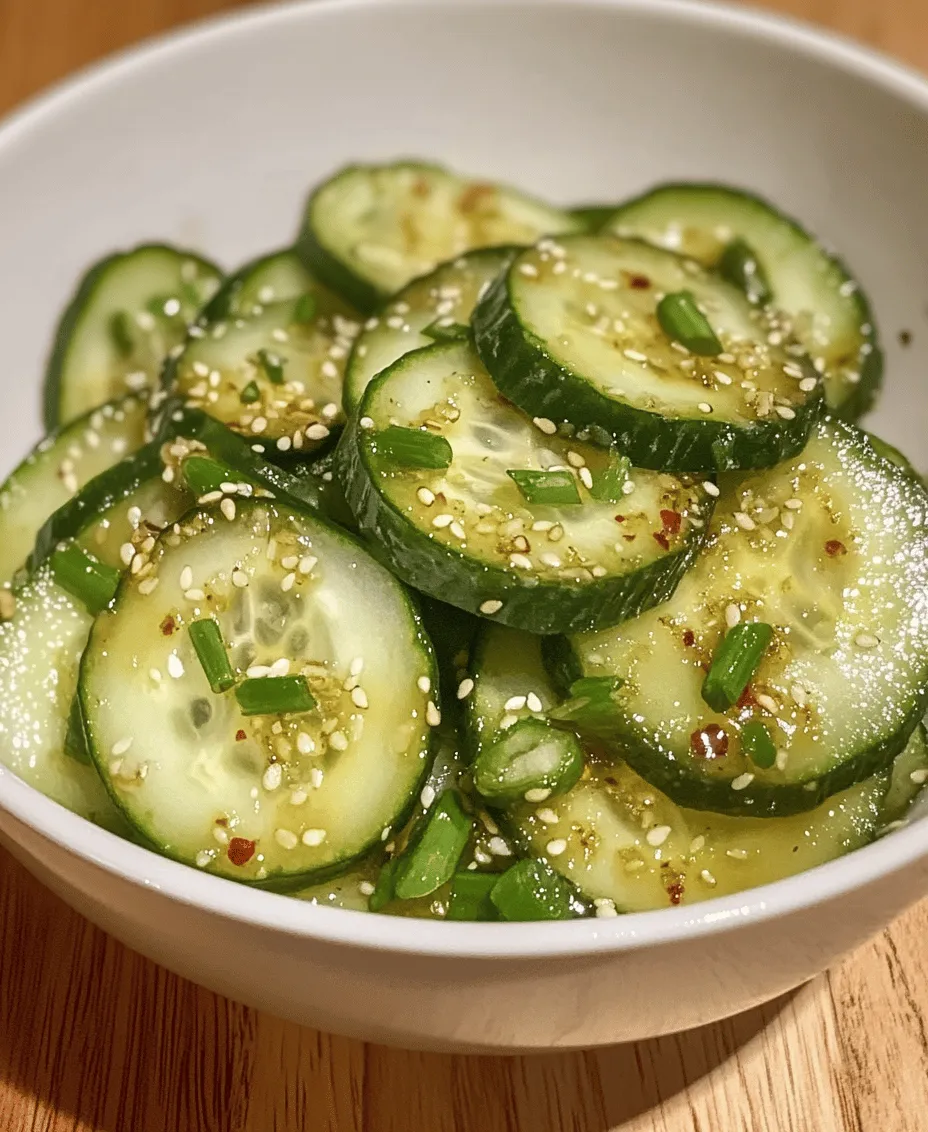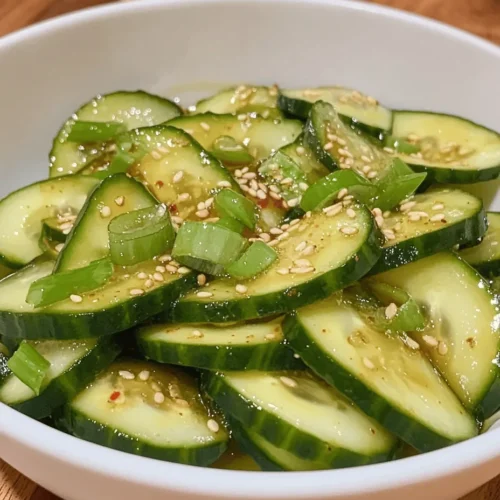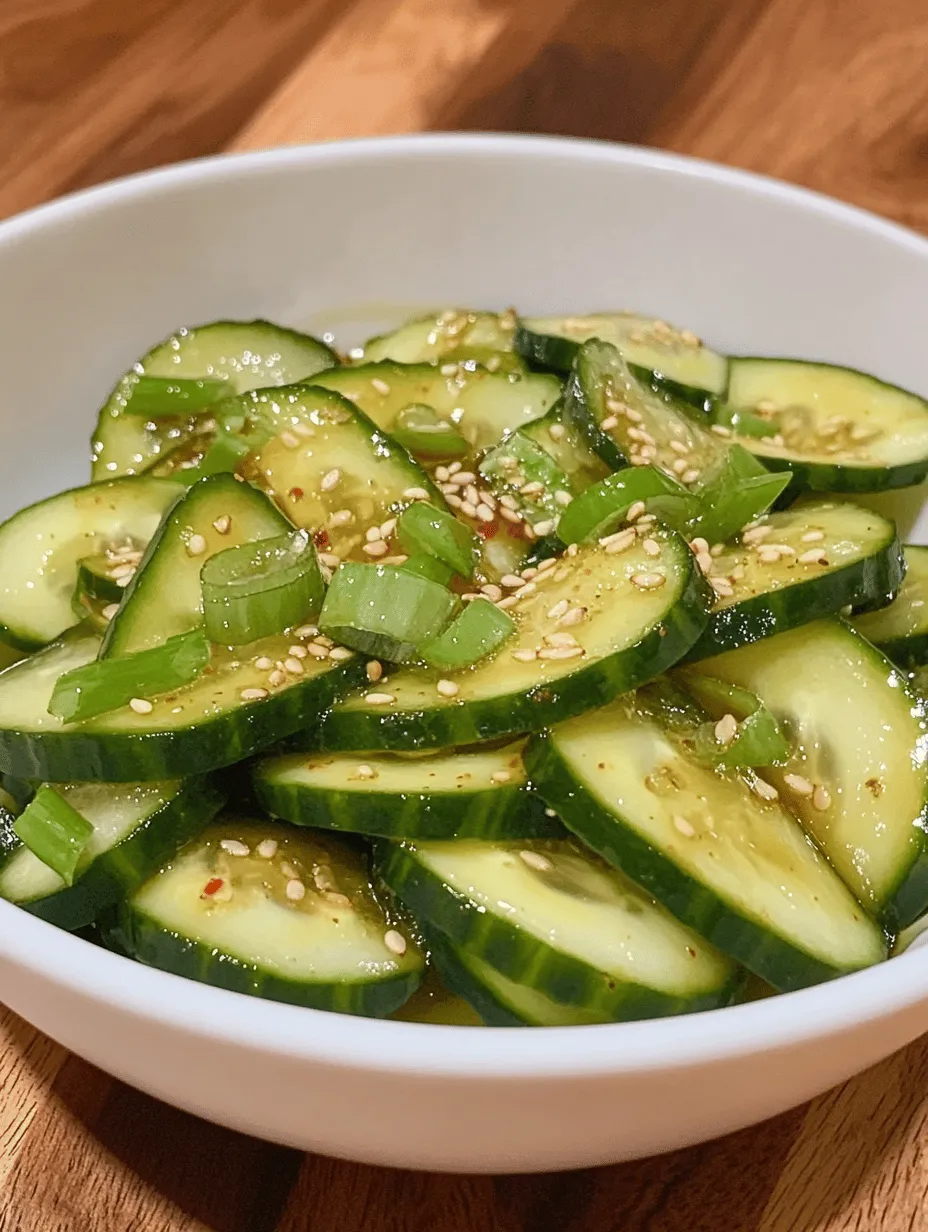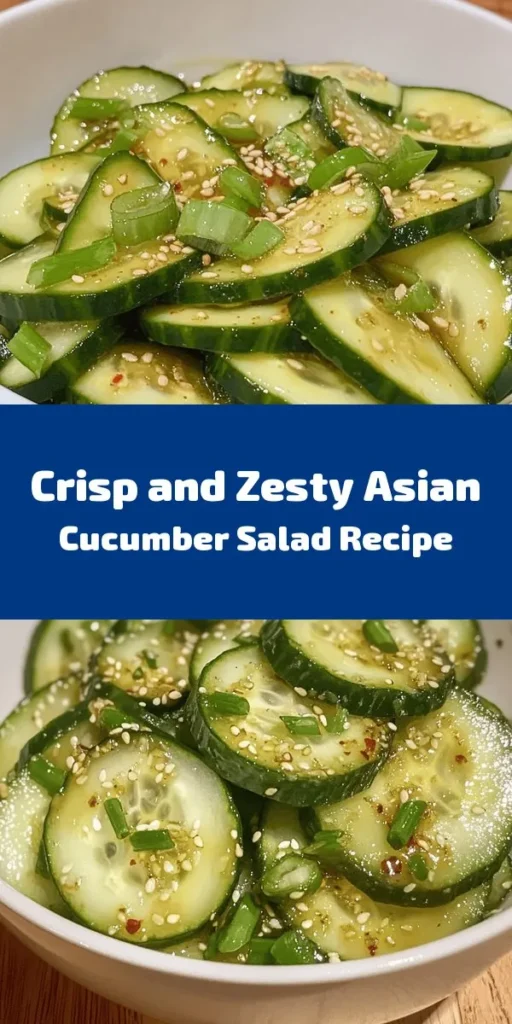Introduction
Welcome to our culinary journey where we explore the vibrant and refreshing flavors of Asian cuisine. Today, we will dive into the delightful world of the Asian Cucumber Salad. This dish not only embodies the essence of freshness but also showcases a perfect balance of sweet, tangy, and savory notes. Ideal for summer gatherings or as a light appetizer, this salad is quick to prepare and packed with nutritious ingredients. The combination of crisp cucumbers and savory dressing creates a refreshing experience that tantalizes the taste buds.
The Asian Cucumber Salad is a staple in various Asian cultures, particularly in countries like China, Japan, and Korea, each with its own unique twist on the dish. It serves as a versatile accompaniment to a range of main courses, or it can stand alone as a light meal. Its origins can be traced back to the need for fresh and light dishes that complement more robust flavors in Asian cooking. This salad is not only a treat for the palate but also a feast for the eyes, with its vibrant colors and textures.
Join us as we break down the recipe for this refreshing salad and explore its cultural significance, health benefits, and variations that can elevate your culinary repertoire. From understanding the core ingredients to mastering the preparation steps, we will guide you through every aspect of creating this delightful dish.
Understanding the Ingredients
Exploring the Core Components of the Salad
A great salad starts with high-quality ingredients. In the case of the Asian Cucumber Salad, each component plays a critical role in crafting the dish’s unique flavor profile. Let’s take a closer look at the essential ingredients that come together to create this refreshing salad.
Overview of English Cucumbers: Texture and Taste
At the heart of this salad lies the English cucumber, known for its crisp texture and mild flavor. Unlike its garden counterpart, the English cucumber has a thinner skin and fewer seeds, making it perfect for salads. Its refreshing crunch provides a satisfying contrast to the dressing, enhancing the overall experience. When selecting cucumbers, look for firm, dark green ones, as they are less likely to be bitter and have a higher water content, adding to the salad’s refreshing nature.
The Role of Salt: Drawing Out Moisture
Salt is a key player in this recipe, often overlooked for its simple yet vital role. When the cucumbers are salted, it draws out excess moisture, preventing the salad from becoming soggy. This process not only enhances the cucumbers’ natural flavor but also improves their texture, making them crunchier. By salting the cucumbers ahead of time, you create a solid foundation for the rest of the flavors to shine through.
Rice Vinegar: A Tangy Foundation
Rice vinegar is another essential ingredient that adds a tangy depth to the salad. Known for its mild flavor compared to other vinegars, it complements the cucumbers without overpowering them. The acidity of rice vinegar brightens the dish and balances the sweetness from other ingredients. It is a staple in Asian cuisine, often used in dressings, marinades, and pickling solutions.
Soy Sauce: The Umami Element
Adding a splash of soy sauce introduces a savory umami element that enhances the salad’s depth. Soy sauce is rich in flavor, providing a perfect counterbalance to the sweetness of other components. For a gluten-free option, consider using tamari, which offers a similar taste profile without gluten. The salty notes of soy sauce elevate the overall essence of the salad, making it irresistible.
Sesame Oil: Imparting Nutty Depth
Sesame oil is a key ingredient that adds a distinctive nutty aroma and flavor to the dressing. It brings warmth and richness to the salad, complementing the freshness of the cucumbers. It’s essential to use toasted sesame oil for a deeper, more complex flavor. A small amount goes a long way, imparting that classic Asian flavor that ties the dish together.
Sweetness: Honey or Maple Syrup Choices
To achieve a harmonious balance of flavors, a hint of sweetness is crucial. You can use honey or maple syrup to add that touch of sweetness. Honey lends a floral note, while maple syrup offers a unique flavor that pairs well with the other ingredients. Both options are natural sweeteners that enhance the overall taste without overwhelming the palate.
Fresh Ginger and Garlic: Aromatic Enhancements
Fresh ginger and garlic are aromatic powerhouses that bring warmth and depth to the dressing. Ginger adds a subtle spiciness and a touch of earthiness, while garlic provides a pungent kick that enhances the overall flavor profile. Together, they create a fragrant base that elevates the salad from simple to sensational.
Sesame Seeds and Green Onions: Texture and Garnish
The finishing touches of sesame seeds and green onions not only add visual appeal but also contribute texture and flavor. Sesame seeds provide a pleasant crunch and nutty flavor, while green onions offer a fresh, crisp bite. When sprinkled on top, these elements enhance the overall presentation of the salad, making it as beautiful as it is delicious.
Optional Heat: The Role of Crushed Red Pepper Flakes
For those who enjoy a bit of heat, crushed red pepper flakes can be added to the dressing for an extra kick. This optional ingredient elevates the flavor profile by introducing a spicy element that contrasts beautifully with the sweetness and tanginess of the salad. Adjust the amount based on your heat preference, ensuring that it complements rather than overwhelms the dish.
Step-by-Step Preparation
Now that we have a thorough understanding of the ingredients, let’s dive into the step-by-step preparation process. Each step is designed to enhance the flavors and textures, resulting in a refreshing salad that is sure to impress.
Preparing the Cucumbers
Salting the Cucumbers for Optimal Texture
Start by washing the English cucumbers thoroughly. Once cleaned, slice them thinly, either into rounds or half-moons, depending on your preference. The key to achieving the best texture is to sprinkle a generous amount of salt over the sliced cucumbers. Allow them to sit for about 15-20 minutes. This process will draw out excess moisture, resulting in crisp cucumbers that maintain their crunch even after being dressed.
Importance of Rinsing and Drying
After the cucumbers have had time to sweat out their moisture, rinse them under cold water to remove excess salt. This step is crucial to prevent the salad from being overly salty. Once rinsed, drain the cucumbers in a colander and pat them dry with paper towels. Ensuring that the cucumbers are dry will help the dressing adhere better, providing a more flavorful experience.
Crafting the Dressing
Whisking Ingredients for a Harmonious Blend
In a mixing bowl, combine the rice vinegar, soy sauce, sesame oil, honey (or maple syrup), freshly grated ginger, and minced garlic. Using a whisk, blend these ingredients until they are well combined and smooth. This is where the magic happens—the flavors meld together to create a harmonious dressing that elevates the cucumbers.
The Balance of Sweet, Sour, and Savory Flavors
Taste your dressing and adjust as needed. If you prefer it sweeter, add a bit more honey or maple syrup. If you want more tang, a splash of extra rice vinegar will do the trick. The goal is to achieve a balanced flavor that highlights the natural taste of the cucumbers while providing a delightful explosion of flavors with each bite.
Combining Elements for Flavor Fusion
Tossing Cucumbers with Dressing
Once the dressing is ready, it’s time to bring everything together. In a large mixing bowl, add the prepared cucumbers and pour the dressing over them. Gently toss the cucumbers in the dressing, ensuring that every slice is evenly coated. This step is essential for allowing the flavors to infuse the cucumbers, creating a delicious salad that is bursting with flavor.
Incorporating Toppings: Sesame Seeds and Green Onions
Finally, sprinkle the salad with toasted sesame seeds and sliced green onions. Toss again to distribute the toppings evenly. These garnishes not only add texture and flavor but also enhance the visual appeal of the salad, making it even more enticing.
With these initial steps, you are well on your way to creating a Refreshing Asian Cucumber Salad that is sure to be a hit at any gathering or meal. Stay tuned for the next part, where we will delve deeper into tips for best results, variations, and answers to common questions about this delightful salad.

Adjusting Heat Level with Red Pepper Flakes
For those who enjoy a little kick in their dishes, red pepper flakes can elevate the flavor profile of the Asian Cucumber Salad significantly. Adjusting the heat level is simple; start with a small amount—about 1/4 teaspoon of red pepper flakes—and toss it into the dressing. Mix well and taste. If you prefer a spicier salad, gradually increase the amount until it reaches your desired heat level. Remember, the goal is to enhance the salad’s refreshing qualities without overpowering the delicate flavors of the cucumbers and herbs.
Chilling for Maximum Flavor
One of the essential steps in preparing the Asian Cucumber Salad is chilling it before serving. Refrigeration allows the flavors to meld beautifully, resulting in a more harmonious taste experience. After mixing the salad components, cover them with plastic wrap or transfer them to an airtight container and chill in the refrigerator for at least 30 minutes, though an hour is preferable. The longer the salad sits, the more pronounced the flavors become, with the cucumbers soaking up the dressing’s essence.
The Importance of Marinating Time
Marinating time is crucial for achieving a well-balanced flavor in the Asian Cucumber Salad. Although the salad can be served immediately after preparation, letting it marinate for at least 30 minutes enhances the flavors significantly. During this time, the cucumbers release some of their natural juices, which combine with the dressing to create a refreshing, tangy sauce that clings to each cucumber slice. If you have the time, allowing the salad to sit for a few hours or even overnight will deepen the flavors further, making it an excellent make-ahead dish.
Serving Suggestions
Presentation Ideas for the Salad
Presentation plays a vital role in the overall dining experience, and this Asian Cucumber Salad is no exception. To enhance its visual appeal, consider using a large, shallow bowl to display the vibrant colors of the ingredients. Layer the cucumber slices attractively, and sprinkle sesame seeds or chopped green onions on top just before serving. For an elegant touch, serve the salad in individual glass cups or jars, allowing guests to appreciate the layers of color and texture.
Plating for Visual Appeal
When plating the salad, consider adding garnishes such as cilantro leaves or a few slices of red chili for a pop of color. Using a ring mold to shape the salad can also create a stunning presentation. Simply pack the salad tightly into the mold and carefully lift it off to reveal a perfect cylinder of colorful ingredients. This technique not only elevates the dish but also makes it a conversation starter at your table.
Pairing with Other Dishes: Complements and Contrasts
The Asian Cucumber Salad is versatile and pairs well with various dishes. Its light, refreshing nature makes it an excellent accompaniment to grilled meats, such as teriyaki chicken, beef skewers, or grilled shrimp. For a vegetarian option, serve it alongside stir-fried tofu or vegetable dishes. The salad’s acidity and crunch provide a delightful contrast to rich, hearty meals, balancing flavors and textures beautifully.
Nutritional Benefits
Health Advantages of the Key Ingredients
Understanding the health benefits of the ingredients in your Asian Cucumber Salad enhances its appeal. Cucumbers, the star of this dish, are primarily composed of water, making them an excellent choice for hydration. They are low in calories while being rich in vitamins K and C, potassium, and magnesium, contributing to overall health.
Cucumbers: Hydration and Nutritional Value
As a hydrating vegetable, cucumbers help keep the body cool during hot summer months, making them an ideal ingredient for salads. Their high water content, which is about 95%, promotes hydration and aids in digestion. The added crunch not only satisfies the palate but also provides a healthy source of fiber.
Ginger and Garlic: Anti-inflammatory Properties
Ginger and garlic, often staples in Asian cuisine, offer numerous health benefits. Ginger is known for its anti-inflammatory properties, which can help alleviate symptoms of nausea and digestive issues. Garlic, on the other hand, is renowned for its immune-boosting effects and ability to lower blood pressure. Together, they create a powerful immune-supporting duo that enhances the salad’s nutritional profile.
Sesame Oil: Healthy Fats and Nutrients
Sesame oil, often used in Asian cooking, is rich in healthy fats, particularly polyunsaturated and monounsaturated fats, which are beneficial for heart health. It also contains antioxidants that help reduce inflammation and oxidative stress in the body. Incorporating sesame oil into your dressing not only adds a rich, nutty flavor but also provides essential fatty acids that promote overall well-being.
The Role of Honey or Maple Syrup in a Balanced Diet
If you choose to sweeten your dressing with honey or maple syrup, you’re adding a touch of natural sweetness that enhances the overall flavor of the salad. Both sweeteners are rich in antioxidants and provide energy. Honey, known for its antibacterial properties, is a great option, while maple syrup offers a unique flavor and a lower glycemic index than traditional sugars, making it a suitable choice for those watching their sugar intake.
Cultural Significance
The Role of Cucumber Salad in Asian Cuisine
Cucumber salad holds a special place in various Asian cuisines, often served as a refreshing side dish to complement heavier main courses. In countries like Japan and Korea, such salads are common during summer months, providing a cooling element to the dining experience. Each culture has its unique twist on cucumber salad, from the use of different dressings to the addition of various ingredients, showcasing the versatility of this humble vegetable.
Traditional Uses in Various Asian Cultures
In Japan, cucumber salads often incorporate miso dressing or vinegar, while Korean cucumber salads may feature a spicy gochugaru seasoning. In China, you may find cucumber salads dressed with soy sauce, vinegar, and garlic, highlighting the importance of balance in flavors. These variations reflect each culture’s culinary traditions and the seasonal ingredients that inspire them.
How This Salad Reflects Seasonal Eating
The Asian Cucumber Salad is a perfect example of seasonal eating, as cucumbers are typically harvested in the summer months. This salad celebrates the freshness of seasonal produce, encouraging cooks to utilize local ingredients. Emphasizing seasonal foods not only enhances flavor but also supports sustainable eating practices, making it a responsible choice for health-conscious individuals.
Variations and Modifications
Exploring Creative Twists on the Classic Recipe
While the classic Asian Cucumber Salad is delightful on its own, there are numerous variations you can explore to suit different tastes and dietary preferences. Adding your unique twist can make the dish more exciting and cater to specific dietary needs.
Adding Proteins: Tofu, Chicken, or Shrimp
For those looking to turn this salad into a main dish, consider adding proteins such as grilled chicken, shrimp, or crispy tofu. These additions will provide a satisfying element that transforms the salad into a hearty meal. Simply marinate the protein in a similar dressing before grilling or sautéing, allowing the flavors to meld beautifully.
Incorporating Additional Vegetables: Carrots, Bell Peppers, or Radishes
Enhancing the salad’s nutritional value is easy by incorporating additional vegetables. Shredded carrots add a touch of sweetness and vibrant color, while bell peppers introduce a crisp texture. Thinly sliced radishes can contribute a peppery bite, making the salad even more dynamic. Feel free to experiment with your favorite vegetables for a customized experience.
Vegan or Gluten-Free Adaptations
This Asian Cucumber Salad is inherently vegan and can easily be adapted to meet gluten-free needs. Ensure that the soy sauce used in the dressing is gluten-free, or substitute it with tamari. If you’re looking to reduce sugar, opt for a sugar alternative that fits your dietary preferences while maintaining the salad’s flavor profile.
Conclusion
The Asian Cucumber Salad is more than just a side dish; it’s a celebration of freshness, flavor, and health. With its simple yet delicious ingredients, this salad is a testament to the beauty of Asian culinary traditions. Whether served at a summer barbecue, a family dinner, or as a light snack, it offers a refreshing escape from heavier meals. Embrace the vibrant flavors and enjoy this delightful salad as a versatile addition to your recipe repertoire. Happy cooking!



